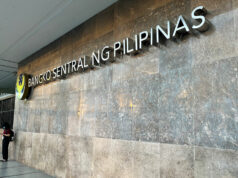DoF sees possible S&P upgrade within a year
THE Department of Finance (DoF) said a credit rating upgrade from S&P Global Ratings is “possible” within a year’s time, to account for reforms in the tax regime and greater ease of doing business.
Undersecretary Gil S. Beltran said the Philippines a credit rating upgrade from S&P could be in the works “within one year” as the government continues to rationalize the tax system.
“One year. It’s possible we get it in one year. Especially if we get the four tax reforms in place,” Mr. Beltran told reporters Saturday during the 2019 Economic Journalists Association of the Philippines Business Journalism Seminar in Baguio City.
In April 2018, the credit rater bumped up its outlook on the Philippine economy to “positive” from “stable,” raising the chances of a credit rating upgrade in the short term. It took stock of tax reform and improved fiscal policies which support solid economic growth.
The Philippines currently holds a “BBB” rating from S&P, which is a notch above minimum investment grade. The rating had a “stable” outlook since April 2015 prior to the 2018 revision.
The government is pushing for comprehensive tax reform to simplify the regime and generate more revenue to support its infrastructure program and expand social services.
Signed into law in December 2017, the Tax Reform for Acceleration and Inclusion Act or the first package imposed excise taxes on certain commodities and updated income tax brackets which raised take-home pay for many taxpayers.
Meanwhile, the package 1B or the Tax Amnesty Act was enacted on Feb. 14, providing relief for delinquent accounts up to year 2017. However, provisions on the relaxation of the deposit secrecy law and the automatic exchange of information with foreign tax authorities were not included in the signed law.
Mr. Beltran, who is also the chief economist of the DoF, said the Philippines may face problems when it comes to attracting foreign investors due to the current state of bank secrecy.
“We cannot even join the ASEAN (Association of Southeast Asian Nations) Trading Link because the investors cannot check the level of creditworthiness of the issuers of the bonds that are in the market.”
A higher credit rating improves the chances for a country to borrow funds from foreign sources at cheaper rates.
Earlier this month, S&P scaled down its growth forecast for the Philippines further to 6.3% from 6.4% previously, citing weaker global demand for exports, as well as higher borrowing costs due to the central bank’s rate hikes in 2018, which will dampen domestic demand.
Apart from S&P, Mr. Beltran said other “big” debt watchers Moody’s Investors Service and Fitch Ratings may upwardly adjust its credit rating as well “If we pass all the tax reform, and then we implement the ease of doing business…”
Enacted last year, the Ease of Doing Business Act aims to eliminate corrupt practices and cut bureaucratic red tape. However, its implementation hangs in the balance as its implementing rules and regulations are still pending.
“For Fitch, we are stable, which means we have to do more to be able to get an upgrade. And for Moody’s, we have to do more to get an upgrade because after being stable for a year, you can get upgrade to positive,” Mr. Beltran said.
The Philippines holds investment grade ratings from Moody’s Investors Service (Baa2, stable) and Fitch Ratings (BBB, stable). — Karl Angelo N. Vidal



